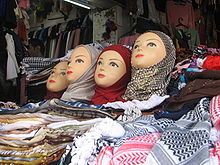- Headscarf
-
- For other uses, see headgear.
 Women's headscarves for sale in East Jerusalem
Women's headscarves for sale in East Jerusalem
Headscarves or head scarves are scarves covering most or all of the top of a woman's hair and her head. Headscarves may be worn for a variety of purposes, such as for warmth, for sanitation, for fashion or social distinction; with religious significance, to hide baldness, out of modesty, or other forms of social convention.
Types
Headscarves may have specific religious significance. Observant married Jewish women, for example, are required to cover their hair, often employing scarves, known as tichels or snoods, in compliance with the code of modesty known as tzniut.
Headscarves were also worn by married Christian women in medieval Europe, and even by some of the unmarried. This headcovering habit is better known as a wimple in English.
 Elizabeth II wearing babushka-type headscarf at a meeting with Ronald Reagan, 1982.
Elizabeth II wearing babushka-type headscarf at a meeting with Ronald Reagan, 1982.
Headscarves and veils are most commonly used by Observant Muslim women. The Muslim religious dress include burqa, chador, niqab, dupatta, and others. The Arabic word hijab, which refers to modest behaviour or dress in general, is often used to describe the headscarf worn by Muslim women. The hijab is worn for religious purposes. Some reasons for Muslim women wearing the hijab would be for modesty and allowing a woman to be judged by her morals, character, and ideals instead of her appearance. A "head dress" could also be worn by men. The most common, keffiyeh, is worn by men (most commonly Middle Eastern) for cultural purposes rather than religious.
Some English speakers use the word "babushka" (grandma in Russian) to indicate the headscarf tied below the chin, as commonly worn in Eastern Europe. In most parts of Eastern Europe, headscarves are used mainly[citation needed] by elderly women (grandmothers) and this led[citation needed] to the use of the "babushka" term. Women in Russia show their convictions to Russian Orthodoxy by wearing headscarves to church. In Chile, Mapuche women wear headscarves tied behind the head.
A plain red or scarlet headscarf was worn by female commissars and other women aligning themselves with Bolshevism in times of Russian revolution and civil war.
A head tie is an elaborate ornamental head covering worn by women of western and southern Africa.
Many women with medical hair loss, due to chemotherapy, alopecia or other causes, utilize scarves as protective head coverings.
See also
- Islamic dress controversy in Europe
- Headscarf controversy in Turkey
- Veil
- Salwar Kameez
- Dupatta
References
External links
Islamic female dress Types In different countries Concepts Categories:- Scarves
- Headgear
- Jewish religious clothing
- Islamic dress (female)
- African clothing
Wikimedia Foundation. 2010.

